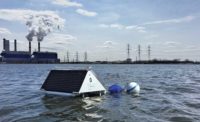American Society of Civil Engineers Ponders the Potential of the Internet of Things

The ‘internet of things’ and ‘pervasive’ communications are seen as keys to ‘instrumenting’ infrastructure to self-alert when trouble is brewing, but other possibilities are only starting to be imagined.
GETTY IMAGES
The Industry Leaders Council of the American Society of Civil Engineers is evaluating submissions to a new contest that is soliciting ideas for transforming the future of infrastructure.
One of the submission categories is seen as especially challenging for engineers because it asks them to dream about something that doesn’t quite yet exist: “the internet of things.”
“This is early-stage thinking,” says Jerry Buckwalter, chair of the ASCE’s innovation committee. “You have to force yourself out of what we pride ourselves on, which is our analytical continuity, and think in wildly different ways. It’s not easy,” Buckwalter says.
The IoT is sometimes described as the “convergence of mobility, cloud and big data,” Buckwalter explains. “It connects people, data, things and processes in massive networks, creating vast amounts of information that, when analyzed and used intelligently, could create new innovations and efficiencies.”
Buckwalter says the question being asked is, how can we design the IoT and other responsive technologies into infrastructure and civil engineering projects?
Bob Prieto, CEO of Strategic Program Management LLC, is the contest chair. “There is a lot of power in the internet of things,” he says. “We are still learning that power like we were learning in the early days of the internet.”
“When the internet got beyond a closed community and became something that was open and people could engage with it, the internet became a preferred communication tool. It supplanted a lot of existing communications protocols, and it connects groups of people with knowledge they would never have access to and with people they would otherwise never have known,” Prieto observes.
“We went from connectivity to interconnectivity—a mesh of connections,” he says.
“The internet of things provides that same level of connectivity. But, instead of being connections between people, it is connections between devices. Instead of people informing devices, it’s devices informing people,” Prieto says.
Linking sensor data to enable smart transportation infrastructure is the first example that springs to mind, says Ray Heider, an adviser to the group and a former Northrop Grumman vice president for intelligence strategy and cross-sector initiatives.
“The aerospace industry has done this for a long, long time.” Heider says.
“Everything built in the aerospace world largely depends on sensors for testing or performance.” He says infrastructure can be instrumented to constantly produce data and software can be written to look for exceptions to established parameters and, when they are exceeded, “call for help.”
“That would save a lot of time and money in inspections,” Heider says.
Prieto adds visions of other uses of the IoT, such as automating supply-chain management to improve materials deliveries on busy construction sites. He sees it automatically shifting crews as tasks are completed and pushing updates to workplans and schedules. And he sees it as alerting personnel in danger zones to transient safety risks, such as when setting up for a big lift. It would warn them when to clear away and signal when it is safe to return.
“If tools and equipment are communicating with the IoT—and it is location-aware—systems can match up the collocation of a task to be performed and its requirements with the individual, their equipment and materials, and soft items, [such as] their training and certifications,” Prieto says. “That can all happen in an automated way so that exceptions to predetermined parameters are reported and the worker may [for example] be communicated with to ‘Stop—you don’t have the respirator you need to enter that space.’ ”
“The internet of things could provide a level of safety assurance that your rules and procedures are being adhered to,” Prieto says.



